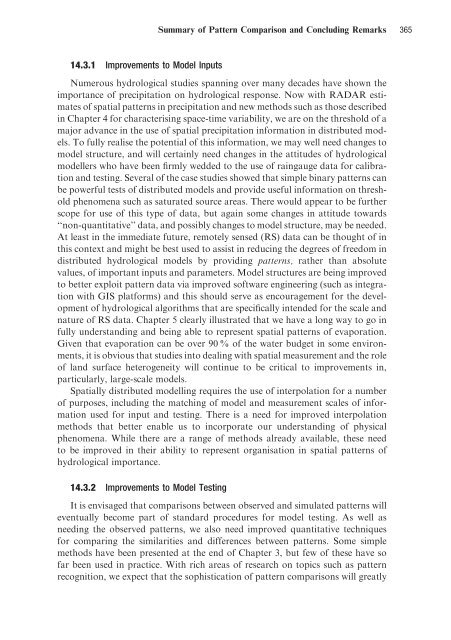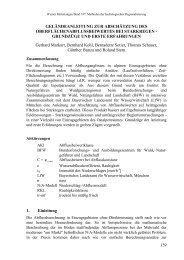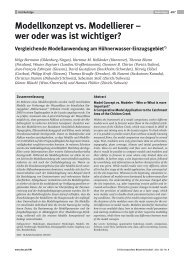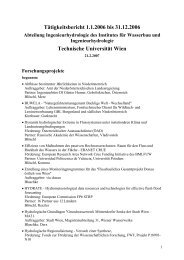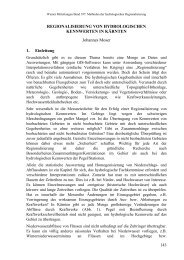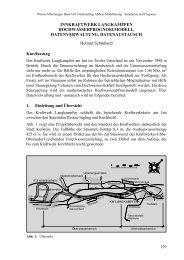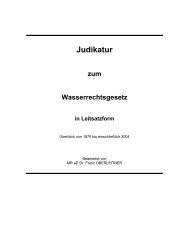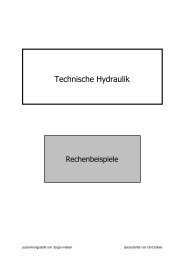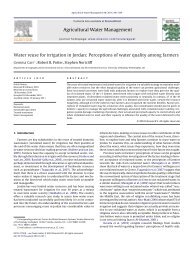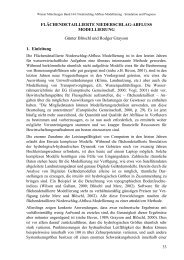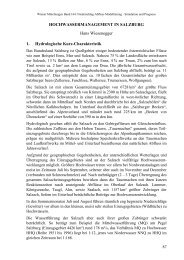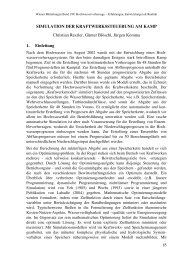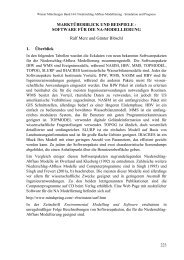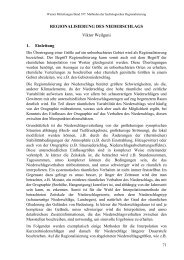Summary of Pattern Comparison and Concluding Remarks
Summary of Pattern Comparison and Concluding Remarks
Summary of Pattern Comparison and Concluding Remarks
Create successful ePaper yourself
Turn your PDF publications into a flip-book with our unique Google optimized e-Paper software.
<strong>Summary</strong> <strong>of</strong> <strong>Pattern</strong> <strong>Comparison</strong> <strong>and</strong> <strong>Concluding</strong> <strong>Remarks</strong> 365<br />
14.3.1 Improvements to Model Inputs<br />
Numerous hydrological studies spanning over many decades have shown the<br />
importance <strong>of</strong> precipitation on hydrological response. Now with RADAR estimates<br />
<strong>of</strong> spatial patterns in precipitation <strong>and</strong> new methods such as those described<br />
in Chapter 4 for characterising space-time variability, we are on the threshold <strong>of</strong> a<br />
major advance in the use <strong>of</strong> spatial precipitation information in distributed models.<br />
To fully realise the potential <strong>of</strong> this information, we may well need changes to<br />
model structure, <strong>and</strong> will certainly need changes in the attitudes <strong>of</strong> hydrological<br />
modellers who have been firmly wedded to the use <strong>of</strong> raingauge data for calibration<br />
<strong>and</strong> testing. Several <strong>of</strong> the case studies showed that simple binary patterns can<br />
be powerful tests <strong>of</strong> distributed models <strong>and</strong> provide useful information on threshold<br />
phenomena such as saturated source areas. There would appear to be further<br />
scope for use <strong>of</strong> this type <strong>of</strong> data, but again some changes in attitude towards<br />
‘‘non-quantitative’’ data, <strong>and</strong> possibly changes to model structure, may be needed.<br />
At least in the immediate future, remotely sensed (RS) data can be thought <strong>of</strong> in<br />
this context <strong>and</strong> might be best used to assist in reducing the degrees <strong>of</strong> freedom in<br />
distributed hydrological models by providing patterns, rather than absolute<br />
values, <strong>of</strong> important inputs <strong>and</strong> parameters. Model structures are being improved<br />
to better exploit pattern data via improved s<strong>of</strong>tware engineering (such as integration<br />
with GIS platforms) <strong>and</strong> this should serve as encouragement for the development<br />
<strong>of</strong> hydrological algorithms that are specifically intended for the scale <strong>and</strong><br />
nature <strong>of</strong> RS data. Chapter 5 clearly illustrated that we have a long way to go in<br />
fully underst<strong>and</strong>ing <strong>and</strong> being able to represent spatial patterns <strong>of</strong> evaporation.<br />
Given that evaporation can be over 90 % <strong>of</strong> the water budget in some environments,<br />
it is obvious that studies into dealing with spatial measurement <strong>and</strong> the role<br />
<strong>of</strong> l<strong>and</strong> surface heterogeneity will continue to be critical to improvements in,<br />
particularly, large-scale models.<br />
Spatially distributed modelling requires the use <strong>of</strong> interpolation for a number<br />
<strong>of</strong> purposes, including the matching <strong>of</strong> model <strong>and</strong> measurement scales <strong>of</strong> information<br />
used for input <strong>and</strong> testing. There is a need for improved interpolation<br />
methods that better enable us to incorporate our underst<strong>and</strong>ing <strong>of</strong> physical<br />
phenomena. While there are a range <strong>of</strong> methods already available, these need<br />
to be improved in their ability to represent organisation in spatial patterns <strong>of</strong><br />
hydrological importance.<br />
14.3.2 Improvements to Model Testing<br />
It is envisaged that comparisons between observed <strong>and</strong> simulated patterns will<br />
eventually become part <strong>of</strong> st<strong>and</strong>ard procedures for model testing. As well as<br />
needing the observed patterns, we also need improved quantitative techniques<br />
for comparing the similarities <strong>and</strong> differences between patterns. Some simple<br />
methods have been presented at the end <strong>of</strong> Chapter 3, but few <strong>of</strong> these have so<br />
far been used in practice. With rich areas <strong>of</strong> research on topics such as pattern<br />
recognition, we expect that the sophistication <strong>of</strong> pattern comparisons will greatly


